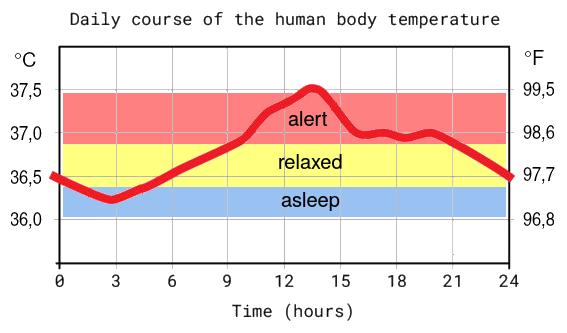- The lower the core body temperature, the more drowsy we become.
- Applying heat to the body’s surface will cool the body’s core.
- Hands, feet and face cheecks are exceptions to the rule.
- The temperature manipulation must happen outside of the bed.

The core body temperature plays an instrumental role in our wake state. It’s not constant but follows its own curve, rising and falling throughout the day within a normal healthy range. If the temperature rises, we become more awake and alert; if it starts dropping, the become relaxed and drowsy; and below a certain threshold, we inevitably fall asleep.
Manipulation with inverse stimuli
It is possible to manipulate the core body temperature to a some extend, thereby enhancing our ability to fall asleep. This manipulation works with inverse stimuli: When we apply heat to the body’s surface, the core temperature starts dropping in order to retain the temperature level. Equally, the core temperature starts rising when cold is applied to the surface.
Face, feet and hands
There are three areas on the body where this mechanism doesn’t work. Those are the feet, hands and face cheeks, which are the body’s heat exchange zones. Exposing them to heat will increase the core temperature, while applying cold to them will cool down the core temperature. This means, the mechanism isn’t fully adjustable, and requires some trial and error to find the individually optimal configuration.
Sauna, bath and bed
On the practical level, various methods can be used to warm the body’s surface, such as taking a hot shower or bath before going to bed, or using an infrared sauna blanket. It is essential, though, to do the temperature manipulation outside of the bed. The bedroom itself should be cool so the body can keep releasing excess heat during the night. Otherwise, if hands and feet are kept warm under the blanket in a warm bedroom, the sleep will likely be shallow and poor.
